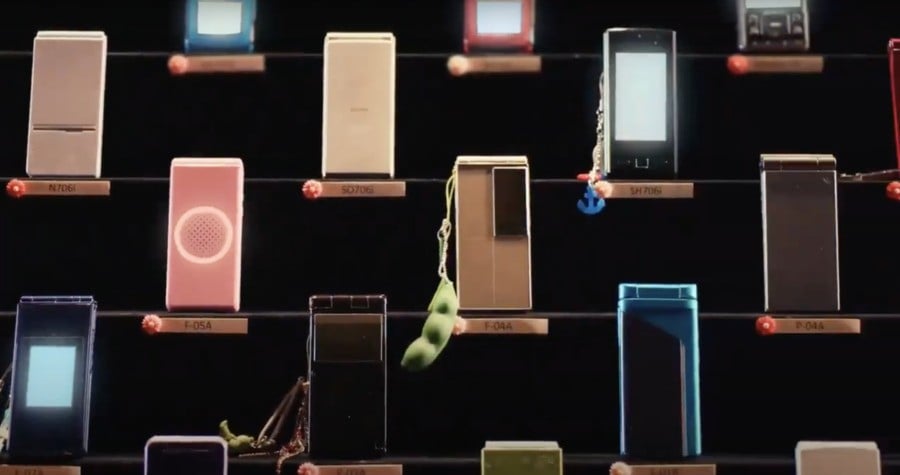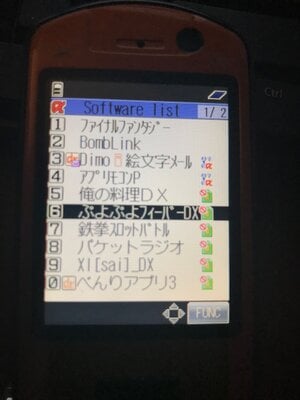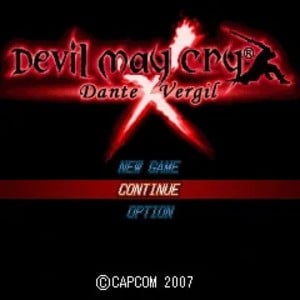
Don't worry – you're not suffering from déjà vu. If you feel like you've read this before, it's because we're republishing some of our favourite features from the past year as part of our Best of 2024 celebrations. If this is new to you, then enjoy reading it for the first time! This piece was originally published on February 1st, 2024.
Before iPhone and Android devices became the primary platforms for mobile gaming, there was already a healthy community of gamers in Japan experiencing the joy of playing video games on their phone, thanks to the emergence of Japanese feature phones.
These proto-smartphones let users connect to the internet to access video games and other utilities from a bunch of different mobile carriers, with the three most popular services being NTT DoCoMo's i-Mode, Softbank's Yahoo! Keitai, and Au's EZ Web. Various well-known developers/publishers like Capcom, Square Enix, Sega, and Konami have all released games for these services in the past (including some based on their most popular franchises). However, they have historically fallen through the cracks when it comes to preservation, due to the challenge of actually accessing these games and the general lack of awareness surrounding their existence.
Fortunately, this has all started to change over the last few years, with a passionate group of researchers, hackers, and emulation experts coming together in the hopes of saving these games from being lost forever. This group has made incredible strides over just a short period, and we've done our best to keep up, reporting on its preservation of mobile demos of Final Fantasy VII: Dirge of Cerberus and Biohazard The Stories (for instance!). But we felt it was finally time to dig a little deeper into the topic. So we reached out to RockmanCosmo to be our guide through this fascinating and forgotten era of gaming and to give us an insight into what's being done to rescue these games from oblivion.
A Call To Action
According to Cosmo, he first became interested in preserving Japanese feature phone games through his involvement in the Mega Man community. As he tells us, one day when he was scrolling through Twitter, he saw Protodude, the owner of Rockman Corner, retweet a post featuring a video of Rockman.EXE Phantom of Network (one of the many Mega Man games that Capcom released for i-Mode compatible devices) being played on a mobile phone and ask his followers for more information regarding the specific type of model. Cosmo immediately responded with a bunch of his findings and the next thing he knew he was being added to a small Twitter DM group, which was put together to help research and preserve various Mega Man feature phone titles (including Rockman.EXE Phantom of Network and its follow-up Rockman.EXE Legend of Network).
"That ended up being the start of this feature phone preservation project," says Cosmo. "At the time, another person knew a kind Japanese user who had these Mega Man Battle Network games on their phone and was willing to give it to us. So it all just started right there. My initial role was just recruiting programmers, researching device manuals, and kind of doing some outreach stuff. But then Protodude became busy with other commitments and I took on a leadership role."
He continues, "I wasn’t looking at other Japanese feature phone games because I was so focused on these Mega Man ones. But as I started to recruit people, I got into Kahvibreak – that Discord Sever that has a lot of people who do this kind of preservation – and I started seeing there are a lot of other games that have unique outings for these services, like Final Fantasy VII, Kingdom Hearts, and Professor Layton — the list goes on and on. I started becoming more aware of that. But I still hadn’t put myself out there as someone who advocates for them as a whole. That all changed in the Summer of 2021"
That Summer, Cosmo came across some shocking news: the i-Mode website (which was an online storefront used to purchase these kinds of games) was going to shut down in November potentially resulting in thousands of games becoming lost forever. At the time, both AU and Softbank had already shut down their services, meaning the only way to locate new games for these platforms was to buy large bins of used phones and hope that the previous owner hadn't wiped their data. i-Mode games were about to face the exact same fate, and as far as Cosmo was concerned, nothing was being done to raise awareness.

"I was like, ‘How can this be happening?’" he tells us. "And ‘How come no one is talking about this?’ I was looking at all these game preservationist organisations and nobody was saying anything and the date was just getting closer and closer. So I got worried and pretty much totally out of nowhere I decided to write an open letter to a few different organisations in October, telling them, ‘Hey, you guys have got to start raising awareness of this because thousands of games are going to get lost to time.’"
As a direct result of Cosmo's open letter, the Game Preservation Society in Japan was able to successfully download 876 DoCoMo games before the shutdown occurred on November 30th, but these games now sit on aging hardware with the process of removing them from a device being far from simple.
One strategy that has seen the most results is "the debug cable method". This is a method, devised by the Kahvibreak user XYZ, that involves shorting specific pins on the FOMA side of a cable to dump internal memory contents of some compatible DoCoMo phones using some Linux scripts. This supports a bunch of Panasonic and NEC DoCoMo phones and is behind most of the recent game dumps that Cosmo has been talking about on Twitter. Another separate method, meanwhile, involves the use of an SD card but is still very much a work in progress.
"When an i-appli, which is what they call an app on a DoCoMo phone, gets moved to an SD card it becomes encrypted with CPRM and this other C2 cipher," says Cosmo. "So that's really hard. Because we’ve got game dumps that are on SD cards. We’ve got some files from Kingdom Hearts: Coded that are stuck on an SD card and we’ve also got Rockman DASH: Great Adventure on 5 Islands and even more games. But all of that is encrypted.
"We had no idea of how to get around this for a while because you need a lot of different items to crack the CPRM. Most notably an S-Box, a device key, and a bind ID. I’m really simplifying things here."
Some progress has been made in trying to decrypt these games according to Cosmo, with Kahvibreak members managing to find a substitute S-Box from an old Samsung Galaxy S II, in addition to brute forcing a Device Key. However, they've still yet to come up with a set of reliable tools to quickly obtain the individual bind IDs specific to each game, with a member currently working on a program as we speak. As a result, these games are still locked away on SD Card, but there's the very real possibility of one day cracking this vault wide open and accessing its contents.
Emulation Options
Of course, gaining access to these titles only represents half the battle. Another key problem that feature phone preservationists face is the lack of emulation options available for getting these games up and running.

Right now, there is no comprehensive solution for emulating Japanese feature phone services, due to all of the different carriers having their own unique development platforms that are distinct from one another.
i-mode games, for instance, use DoCoMo Java, while Softbank games run on Java Micro Edition with their own custom API (Application Programming Interface). As for the AU EZWeb titles, they initially started out using Jave Micro Edition but at some point swapped over to Qualcomm’s BREW instead — the same development environment that, Cosmo tells us, was used for the Brazilian home console the Zeebo.
"For the DoCoMo games or the DoJa games, we did find one emulator embedded inside an SDK for the DoJa 5.1 version," says Cosmo "But that one’s not very good. It kind of sucks with some 3D games and even some 2D games are hard to put on there. And then installing the emulator is super convoluted because you’ve got to set up a different version of JAVA and set up directories."
He continues, "Someone else also discovered that Softbank had its own official mobile development SDK that has an emulator inside of it, but that’s not really compatible with all of the Softbank games because it lacks some libraries. As for BREW games (i.e. the EZWeb games), they basically have nothing. All they have is an emulator called Melange. And that is single-handedly developed by one user [and has no sound support]."
What all of this essentially means is that even if the group does manage to find and preserve a game, there's no guarantee they'll be able to get it to work.
There is some hope, though. As Cosmo tells us, there is an individual named Stephanie "XerShadowTail" Gawroriski, who is currently working on a promising emulator called SquirrelJME. This aims to handle pretty much anything that’s JAVA Micro-Edition based, which includes i-mode and Softbank titles. Cosmo put us in touch with Gawroriski to learn a bit more about this emulator.
"I started work on SquirrelJME in 2016, so pretty much 7 years ago," Gawroriski tells us over email. "It was February of 2016. SquirrelJME was very much a distraction to keep me occupied and busy, working to reach goals and otherwise. For a while, I was only aiming to create my own Java virtual machine for embedded devices and I didn't really have preservation in mind. However, that would start to change slowly as people got interested in the project because of its future-proofness."
As of this moment, SquirrelJME is currently on version 0.4.0, but there's a roadmap of features already in place for the next four major updates. i-mode support is currently slated to be released in update 0.6.0, along with support for a range of different phone provider APIs.
For Gawroriski, making sure all these APIs are supported by the emulator is one of the biggest challenges associated with the project, with the software developer comparing it to "reinventing the wheel" over and over again:
"I would say [the biggest challenge in emulating these titles is] reinventing the wheel over where those wheels are completely different and they cannot be in place of another. There is DoJa which is basically a complete rewrite of MIDP (Mobile Information Device Profile) and other related classes, with their own stuff on top. Then for Star (the successor to DoJa) they took DoJa and rewrote it again to something similar but not too similar. So I suppose when it comes to these APIs, and every other API like this, it is [good to think of it] like a giant onion of sorts where everything is layered on top of each other. That is pretty much the only way to keep my sanity, since as much as I like writing UI frameworks I do not want to write and rewrite one six times in a row like I did already for MIDP since UI frameworks are very difficult to get right and they are always horrible."
If you like a series and you see that a game is part of this, then go ahead and talk about it. The more people talk about it, the more word about it is going to spread. And the more word spreads, the more chance there is that technically-minded people who can help us will learn about it and want to join in.
As you can probably tell from all of the above, feature phone preservation is still very much in its infancy, but a ton of exciting progress is being made regularly, with this Google Spreadsheet showing all of the amazing titles the preservationists have managed to rescue so far.
We asked Cosmo what people can do to help the ongoing efforts, and he told us that simply raising awareness of these games was enough, as it may one day lead to someone with the right skills learning about these titles and deciding to lend a hand.
"It doesn’t have to be like, ‘Oh, look at all these Keitai games, I'll try to preserve them all’," says Cosmo. "If you like a series and you see that a game is part of this, then go ahead and talk about it. The more people talk about it, the more word about it is going to spread. And the more word spreads, the more chance there is that technically-minded people who can help us will learn about it and want to join in. So spreading the word and word of mouth have been the main thing."
If you're interested in getting involved with these efforts, you can join the Kahvibreak Discord server (a link can be found here) for more information.
We also recommend checking out Cosmo's articles for the website HitSave too, which goes into detail about the current state of feature phone preservation.
